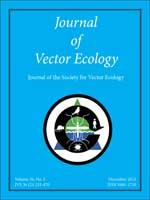A survey of distribution patterns of floodwater mosquito eggs related to environmental conditions such as moisture and plant associations was conducted by using soil samples from irrigated fields in Wrocław, Poland. Mosquito egg distribution was determined by repeatedly flooding the soil samples with aerated water at a temperature of 25° C. Under laboratory conditions, hatching in installments of Aedes caspius (Pallas) and Aedes vexans (Meigen) were commonly observed. The results show that ∼∼75% of the larvae of Ae. caspius and Ae. vexans hatched after the first flooding under summer-like conditions, whereas, following the second and third flooding, the numbers of hatched larvae were significantly lower. In our study, within one intermediate flooded field, a total of 66 plant species was identified and classified into six communities. All vegetation types were associated by varied egg densities and showed differences both in richness and Shannon-Wiener diversity index as well as in ecological indices for moisture, soil reaction, and nutrient level. Small changes in elevation along the slope within the study area showed a large difference in the distribution of mosquito eggs. The highest average egg density was observed in zones with high occurrence of Phalaris arundinacea, usually prevalent in intermediate flooded and fertile areas. Knowledge of the indicators for the distribution of floodwater mosquito eggs in temporary breeding sites may be essential for organizing a successful, integrated mosquito control program with special regard to microbial control agents.
How to translate text using browser tools
1 December 2011
Environmental Factors Associated with the Distribution of Floodwater Mosquito Eggs in Irrigated Fields in Wrocław, Poland
Katarzyna Rydzanicz,
Zygmunt Kącki,
Piotr Jawień
ACCESS THE FULL ARTICLE
It is not available for individual sale.
This article is only available to subscribers.
It is not available for individual sale.
It is not available for individual sale.

Journal of Vector Ecology
Vol. 36 • No. 2
December 2011
Vol. 36 • No. 2
December 2011
Floodwater mosquitoes
irrigation fields
oviposition behavior
plant bioindicators




